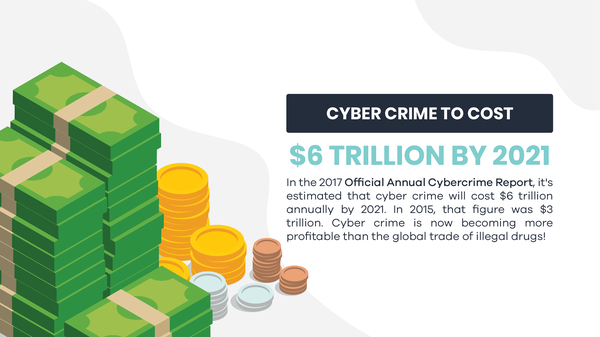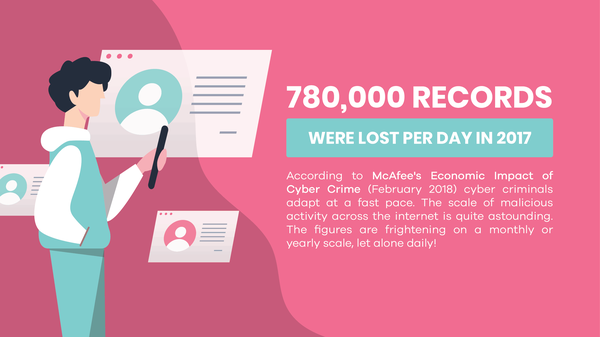Terrifying cyber crime statistics in 2018
Unfortunately, with technology on the rise, there’s more room for cyber crime in 2018. According to the Cyber Security Breaches Survey 2018, 43% of businesses were a victim of a cyber security breach in the last 12 months. In the U.S., the state of California lost more than $214 million through cyber crime alone. With evolving technology comes evolving hackers; the world are not keeping up with the fight against cybercrime – and that’s scary!
Let’s see some terrifying cyber crime statistics in 2018
#1 | 780,000 records were lost per day in 2017
According to McAfee’s Economic Impact of Cyber Crime (February 2018) cyber criminals adapt at a fast pace. The scale of malicious activity across the internet is quite astounding. The figures are frightening on a monthly or yearly scale, let alone daily! Cyber criminals are constantly finding new technologies to target victims. With the introduction of Bitcoin, payment and transfers to/from cyber criminals is untraceable.
McAfee reports that one of the major internet service providers (ISP) sees 80 billion malicious scans a day
#2 | Over 24,000 malicious mobile apps are blocked daily
Symantec’s Internet Security Threat Report details that lifestyle apps are the main targets. The majority of these apps leak phone numbers. Further sensitive information like device location is also being made accessible. It would be completely impossible to monitor or check each of these apps for vulnerability issues. It’s essentially an open ticket for cyber criminals to do their worst.
In the first quarter of 2018, Google Play had over 3.8 million apps on their store.
#3 | Microsoft Office file formats are the most used file extensions
In the top 10 most malicious file extensions, Microsoft Office took the number 1 spot. Emails are a common way for cyber criminals to attack their victims. Emails are used on a daily basis around the world. If you see an email containing a .doc or .xls file extension, most users would relate it to Microsoft. Microsoft being a reputable company means people are more likely to open an attachment.
According to Cisco’s 2018 Annual Cybersecurity Report, 38% were Office formats
#4 | The U.S., U.K., & China are more vulnerable to Smart Home attacks
The majority of smart home devices are connected via an external network. If the router you’re using doesn’t have decent security protection, you could be opening up your home to a cyber attack. With smart home devices becoming more prevalent, criminals are finding new ways to exploit vulnerabilities.
According to Trend Micro, The U.S., accounted for 28% of smart home device incidents. The U.K. and China followed with 7% each
#5 | 21% of files aren’t protected
Varonis’s 2018 Global Data Risk Report is quite terrifying. 6.2 billion files were analysed. These files contained credit card information, health records, etc. 21% of these files were open for global access. Furthermore, 41% of companies have more than 1000 sensitive files open to everyone.
#6 | Healthcare industry ransomware attacks will quadruple
By 2020, CSO Online predicts ransomware attacks will be quadruple. The healthcare industry gets attacked more than most industries. Thankfully not all attacks will be successful. Healthcare industries should not give into demands and ensure their data is safe and backed up. Phishing emails are particularly common and often where cyber attacks originate from.
#7 | Cyber Crime to cost $6 trillion by 2021
In the 2017 Official Annual Cybercrime Report, it’s estimated that cyber crime will cost $6 trillion annually by 2021. In 2015, that figure was $3 trillion.
Cyber crime is now becoming more profitable than the global trade of illegal drugs!

#8 | 30% of phishing emails in the U.S. are opened
That’s almost one-third of all emails, according to Verizon’s 2018 Data Breach Investigations Report. Phishing emails no longer take the same approach they used to. Do you remember seeing an email from your bank, Apple, PayPal etc. asking for sensitive information? With the figures that high, it’s no wonder cyber criminals are preying on email victims.
So many of us receive these emails each day and 12% are clicking on the links/attachments contained within them
#9 | 58% of U.K. businesses sought cyber security advice
The Cyber Security Breaches Survey 2017 shows U.K. businesses are more aware of cyber issues. However, it also shows that a large percentage of businesses aren’t seeking any advice or potentially protecting themselves from threats.
79% of medium firms sought advice whereas only 50% of micro firms did
#10 | 300 billion passwords worldwide by 2020
It may seem like passwords are dying, due to encryption etc. but according to Cyber Security Media, they’re not. It’s predicted that 300 billion passwords will be used by 2020. That takes into account humans and machines! That’s an awful lot of passwords, all of which require cyber security protection. If not, that’s 300 billion potential threats, worldwide.
#11 | French president Emmanuel Macron emails hacked
Yes, even a president can get hacked! In 2017 Emmanuel Macron’s emails were hacked. His emails were posted online just days before he was due to go head to head against his opponent. 9GB worth of data was posted to Pastebin. Macron’s campaign confirmed it had been hacked.
#12 | More than 60% of fraud originates from mobile devices
The world has gone mobile, and so have fraudsters. 60% of fraud comes from mobile devices; of that figure, 80% comes from mobile apps. Once a cyber criminal has access to your mobile, it can access your mobile banking app and initiate multiple levels of cyber crime. Fraudulent transactions are now over double the value of real transactions.
Read the full article from here


